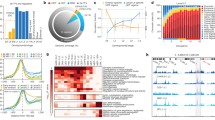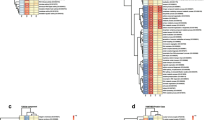Abstract
Regulatory transcription factors operate in networks, conferring biological robustness that makes dissection of such gene control processes difficult. The nematode Caenorhabditis elegans is a powerful molecular genetic system that allows the close scrutiny needed to understand these processes in an animal, in vivo. Strikingly lower levels of gene expression were observed when a gfp reporter was inserted into C. elegans transcription factor genes, in their broader genomic context, in comparison to when the reporter was fused to just the promoter regions. The lower level of expression is more consistent with endogenous levels of the gene products, based on independent protein and transcript assays. Through successive precise manipulations of the reporter fusion genes, elements essential for the lower level of expression were localised to the protein-coding region. With a closer focus on four transcription factor genes, the expression of both genes encoding transcriptional activators was found to be restricted by a post-transcriptional mechanism while expression of both genes encoding transcriptional repressors was delimited by transcriptional repression. An element through which the transcriptional repression acts for unc-4 was localised to a 30 base-pair region of a protein-encoding exon, with potentially wider implications for how homeobox genes operate. The hypothesis that the distinction in mechanisms delimiting expression of the two types of transcription factor genes, as observed here, may apply more widely is raised. This leads to observations concerning the implications of these different mechanisms on stochastic noise in gene expression and the consequent significance for developmental decisions in general.






Similar content being viewed by others
References
Bamps S, Hope IA (2008) Large-scale gene expression pattern analysis, in situ, in Caenorhabditis elegans. Brief Funct Genomic Proteomic 7:175–183
Blumenthal T, Evans D, Link CD, Guffanti A, Lawson D, Thierry-Mieg J, Thierry-Mieg D, Chiu WL, Duke K, Kiraly M, Kim SK (2002) A global analysis of Caenorhabditis elegans operons. Nature 417:851–854
Chen S, Iannolo M, Calvo JM (2005) Cooperative binding of the leucine-responsive regulatory protein (Lrp) to DNA. J Mol Biol 345:251–264
Coates JC, de Bono M (2002) Antagonistic pathways in neurons exposed to body fluid regulate social feeding in Caenorhabditis elegans. Nature 419:925–929
Conaway RC, Brower CS, Conaway JW (2002) Emerging roles of ubiquitin in transcription regulation. Science 296:1254–1258
Dolphin CT, Hope IA (2006) Caenorhabditis elegans reporter fusion genes generated by seamless modification of large genomic DNA clones. Nucleic Acids Res 34:e72
Dupuy D, Bertin N, Hidalgo CA, Venkatesan K, Tu D, Lee D, Rosenberg J, Svrzikapa N, Blanc A, Carnec A, Carvunis AR, Pulak R, Shingles J, Reece-Hoyes J, Hunt-Newbury R, Viveiros R, Mohler WA, Tasan M, Roth FP, Le Peuch C, Hope IA, Johnsen R, Moerman DG, Barabasi AL, Baillie D, Vidal M (2007) Genome-scale analysis of in vivo spatiotemporal promoter activity in Caenorhabditis elegans. Nat Biotechnol 25:663–668
Dupuy D, Li QR, Deplancke B, Boxem M, Hao T, Lamesch P, Sequerra R, Bosak S, Doucette-Stamm L, Hope IA, Hill DE, Walhout AJ, Vidal M (2004) A first version of the Caenorhabditis elegans Promoterome. Genome Res 14:2169–2175
Eastman C, Horvitz HR, Jin Y (1999) Coordinated transcriptional regulation of the unc-25 glutamic acid decarboxylase and the unc-47 GABA vesicular transporter by the Caenorhabditis elegans UNC-30 homeodomain protein. J Neurosci 19:6225–6234
Esmaeili B, Ross JM, Neades C, Miller DM 3rd, Ahringer J (2002) The C. elegans even-skipped homologue, vab-7, specifies DB motoneurone identity and axon trajectory. Development 129:853–862
Fairall L, Buttinelli M, Panetta G (2000) Bandshift, gel retardation or electrophoretic mobility shift assays. In: Travers AA, Buckle M (ed) DNA-protein interactions: a practical approach, chap. 5. Oxford University Press, Oxford
Ferreira HB, Zhang Y, Zhao C, Emmons SW (1999) Patterning of Caenorhabditis elegans posterior structures by the Abdominal-B homolog, egl-5. Dev Biol 207:215–228
Fire A, Ahnn J, Seydoux G, Xu S (1995) FireLab 1995 Vector kit documentation. http://www.addgene.org/docs/fire/andrew/Vec95.pdf
Gregor T, Wieschaus EF, McGregor AP, Bialek W, Tank DW (2007) Stability and nuclear dynamics of the bicoid morphogen gradient. Cell 130(1):141–152
Grove CA, De Masi F, Barrasa MI, Newburger DE, Alkema MJ, Bulyk ML, Walhout AJ (2009) A multiparameter network reveals extensive divergence between C. elegans bHLH transcription factors. Cell 138:314–327
Hill AA, Hunter CP, Tsung BT, Tucker-Kellogg G, Brown EL (2000) Genomic analysis of gene expression in C. elegans. Science 290:809–812
Hollenhorst PC, Shah AA, Hopkins C, Graves BJ (2007) Genome-wide analyses reveal properties of redundant and specific promoter occupancy within the ETS gene family. Genes Dev 21:1882–1894
Hooshangi S, Thiberge S, Weiss R (2005) Ultrasensitivity and noise propagation in a synthetic transcriptional cascade. Proc Natl Acad Sci USA 102:3581–3586
Hope IA (1994) PES-1 is expressed during early embryogenesis in Caenorhabditis elegans and has homology to the fork head family of transcription factors. Development 120:505–514
Huang P, Pleasance ED, Maydan JS, Hunt-Newbury R, O’Neil NJ, Mah A, Baillie DL, Marra MA, Moerman DG, Jones SJ (2007) Identification and analysis of internal promoters in Caenorhabditis elegans operons. Genome Res 17:1478–1485
Huang T, Kuersten S, Deshpande AM, Spieth J, MacMorris M, Blumenthal T (2001) Intercistronic region required for polycistronic pre-mRNA processing in Caenorhabditis elegans. Mol Cell Biol 21:1111–1120
Hunt-Newbury R, Viveiros R, Johnsen R, Mah A, Anastas D, Fang L, Halfnight E, Lee D, Lin J, Lorch A, McKay S, Okada HM, Pan J, Schulz AK, Tu D, Wong K, Zhao Z, Alexeyenko A, Burglin T, Sonnhammer E, Schnabel R, Jones SJ, Marra MA, Baillie DL, Moerman DG (2007) High-throughput in vivo analysis of gene expression in Caenorhabditis elegans. PLoS Biol 5:e237
Jin Y, Hoskins R, Horvitz HR (1994) Control of type-D GABAergic neuron differentiation by C. elegans UNC-30 homeodomain protein. Nature 372:780–783
Johnson RW, Chamberlin HM (2008) Positive and negative regulatory inputs restrict pax-6/vab-3 transcription to sensory organ precursors in Caenorhabditis elegans. Mech Dev 125:486–497
Kim K, Colosimo ME, Yeung H, Sengupta P (2005) The UNC-3 Olf/EBF protein represses alternate neuronal programs to specify chemosensory neuron identity. Dev Biol 286:136–148
Lickteig KM, Duerr JS, Frisby DL, Hall DH, Rand JB, Miller DM 3rd (2001) Regulation of neurotransmitter vesicles by the homeodomain protein UNC-4 and its transcriptional corepressor UNC-37/groucho in Caenorhabditis elegans cholinergic motor neurons. J Neurosci 21:2001–2014
Maere S, De Bodt S, Raes J, Casneuf T, Van Montagu M, Kuiper M, Van de Peer Y (2005) Modeling gene and genome duplications in eukaryotes. Proc Natl Acad Sci USA 102:5454–5459
McGhee JD, Fukushige T, Krause MW, Minnema SE, Goszczynski B, Gaudet J, Kohara Y, Bossinger O, Zhao Y, Khattra J, Hirst M, Jones SJ, Marra MA, Ruzanov P, Warner A, Zapf R, Moerman DG, Kalb JM (2009) ELT-2 is the predominant transcription factor controlling differentiation and function of the C. elegans intestine, from embryo to adult. Dev Biol 327:551–565
Mello CC, Kramer JM, Stinchcomb D, Ambros V (1991) Efficient gene transfer in C. elegans: extrachromosomal maintenance and integration of transforming sequences. EMBO J 10(12):3959–3970
Miller DM 3rd, Niemeyer CJ (1995) Expression of the unc-4 homeoprotein in Caenorhabditis elegans motor neurons specifies presynaptic input. Development 121:2877–2886
Pedone PV, Ghirlando R, Clore GM, Gronenborn AM, Felsenfeld G, Omichinski JG (1996) The single Cys2-His2 zinc finger domain of the GAGA protein flanked by basic residues is sufficient for high-affinity specific DNA binding. Proc Natl Acad Sci USA 93:2822–2826
Prasad B, Karakuzu O, Reed RR, Cameron S (2008) unc-3-dependent repression of specific motor neuron fates in Caenorhabditis elegans. Dev Biol 323:207–215
Prasad BC, Ye B, Zackhary R, Schrader K, Seydoux G, Reed RR (1998) unc-3, a gene required for axonal guidance in Caenorhabditis elegans, encodes a member of the O/E family of transcription factors. Development 125:1561–1568
R Development Core Team (2009) R: A Language and Environment for Statistical Computing. R Foundation for Statistical Computing, Vienna, Austria. http://www.R-project.org
Reboul J, Vaglio P, Rual JF, Lamesch P, Martinez M, Armstrong CM, Li S, Jacotot L, Bertin N, Janky R, Moore T, Hudson JR Jr, Hartley JL, Brasch MA, Vandenhaute J, Boulton S, Endress GA, Jenna S, Chevet E, Papasotiropoulos V, Tolias PP, Ptacek J, Snyder M, Huang R, Chance MR, Lee H, Doucette-Stamm L, Hill DE, Vidal M (2003) C. elegans ORFeome version 1.1: experimental verification of the genome annotation and resource for proteome-scale protein expression. Nat Genet 34:35–41
Reece-Hoyes JS, Shingles J, Dupuy D, Grove CA, Walhout AJ, Vidal M, Hope IA (2007) Insight into transcription factor gene duplication from Caenorhabditis elegans Promoterome-driven expression patterns. BMC Genomics 8:27
Rogers S, Wells R, Rechsteiner M (1986) Amino acid sequences common to rapidly degraded proteins: the PEST hypothesis. Science 234:364–368
Ruzanov P, Jones SJ, Riddle DL (2007) Discovery of novel alternatively spliced C. elegans transcripts by computational analysis of SAGE data. BMC Genomics 8:447
Schrimpf SP, Weiss M, Reiter L, Ahrens CH, Jovanovic M, Malmstrom J, Brunner E, Mohanty S, Lercher MJ, Hunziker PE, Aebersold R, von Mering C, Hengartner MO (2009) Comparative functional analysis of the Caenorhabditis elegans and Drosophila melanogaster proteomes. PLoS Biol 7:e48
Schuske K, Palfreyman MT, Watanabe S, Jorgensen EM (2007) UNC-46 is required for trafficking of the vesicular GABA transporter. Nat Neurosci 10:846–853
Shin H, Hirst M, Bainbridge MN, Magrini V, Mardis E, Moerman DG, Marra MA, Baillie DL, Jones SJ (2008) Transcriptome analysis for Caenorhabditis elegans based on novel expressed sequence tags. BMC Biol 6:30
Simpson ML, Cox CD, Allen MS, McCollum JM, Dar RD, Karig DK, Cooke JF (2009) Noise in biological circuits. WIRES Nanomed Nanobiotechnol 1:214–225
Spieth J, Brooke G, Kuersten S, Lea K, Blumenthal T (1993) Operons in C. elegans: polycistronic mRNA precursors are processed by trans-splicing of SL2 to downstream coding regions. Cell 73:521–532
Sulston J, Hodgkin J (1988) Methods. In: Wood WB (ed) The nematode Caenorhabditis elegans. Cold Spring Harbor Laboratory, Cold Spring Harbor, pp 587–606
Toker AS, Teng Y, Ferreira HB, Emmons SW, Chalfie M (2003) The Caenorhabditis elegans spalt-like gene sem-4 restricts touch cell fate by repressing the selector Hox gene egl-5 and the effector gene mec-3. Development 130:3831–3840
Vermeirssen V, Barrasa MI, Hidalgo CA, Babon JA, Sequerra R, Doucette-Stamm L, Barabasi AL, Walhout AJ (2007) Transcription factor modularity in a gene-centered C. elegans core neuronal protein-DNA interaction network. Genome Res 17:1061–1071
Von Stetina SE, Fox RM, Watkins KL, Starich TA, Shaw JE, Miller DM 3rd (2007) UNC-4 represses CEH-12/HB9 to specify synaptic inputs to VA motor neurons in C. elegans. Genes Dev 21:332–346
Wang BB, Muller-Immergluck MM, Austin J, Robinson NT, Chisholm A, Kenyon C (1993) A homeotic gene cluster patterns the anteroposterior body axis of C. elegans. Cell 74(1):29–42
Westenberg M, Bamps S, Soedling H, Hope IA, Dolphin CT (2010) Escherichia coli MW005: lambda red-mediated recombineering and copy-number induction of oriV-equipped constructs in a single host. BMC Biotechnol 10:27
Winnier AR, Meir JY, Ross JM, Tavernarakis N, Driscoll M, Ishihara T, Katsura I, Miller DM 3rd (1999) UNC-4/UNC-37-dependent repression of motor neuron-specific genes controls synaptic choice in Caenorhabditis elegans. Genes Dev 13:2774–2786
Winston RL, Millar DP, Gottesfeld JM, Kent SB (1999) Characterization of the DNA binding properties of the bHLH domain of Deadpan to single and tandem sites. Biochemistry 38:5138–5146
WormBase (2009) WS200. http://ws200.wormbase.org
Acknowledgments
We thank Mario de Bono for pDONP2P3-SL2-GFP, Alison Baker for pET28cGFP, Colin Dolphin for MW005, and Andrew Smith for technical assistance. We are grateful to Emese Prandovszky for technical suggestions concerning GFP quantification. Some strains used in this work were provided by the Caenorhabditis Genetics Centre, which is funded by the NIH National Centre for Research Resources (NCRR). This research was supported by BBSRC grant BB/E008038/1 and Wellcome Trust Grant 082603/B/07/Z. SB and IAH designed the experiments, SB and JW carried out the experiments, IAH supervised the project and SB and IAH wrote the manuscript.
Author information
Authors and Affiliations
Corresponding author
Additional information
Communicated by T. Ito.
Electronic supplementary material
Below is the link to the electronic supplementary material.
Rights and permissions
About this article
Cite this article
Bamps, S., Wirtz, J. & Hope, I.A. Distinct mechanisms for delimiting expression of four Caenorhabditis elegans transcription factor genes encoding activators or repressors. Mol Genet Genomics 286, 95–107 (2011). https://doi.org/10.1007/s00438-011-0630-3
Received:
Accepted:
Published:
Issue Date:
DOI: https://doi.org/10.1007/s00438-011-0630-3




